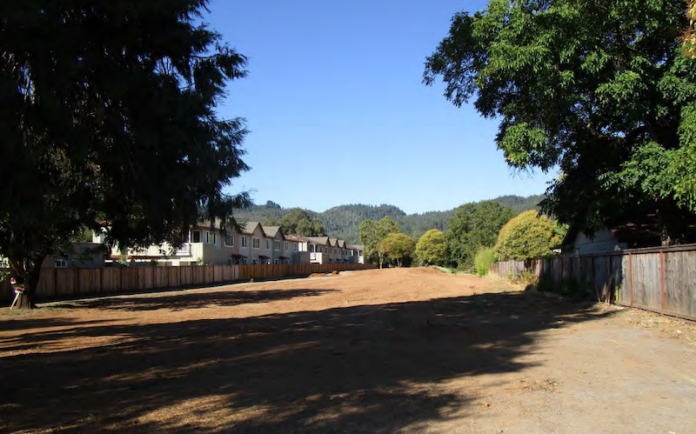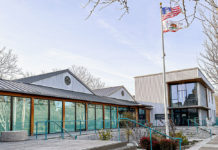
Last week, the Cloverdale City Council held a public hearing for — and voted 3-2 to approve — a zoning change, design review, general plan map amendment and a mitigated negative declaration for a 22-unit development on South Cloverdale Boulevard. The development is phase two of the Taylor Lynn Apartments, and will be located at 669-679 South Cloverdale Boulevard.
When it came time for the council to vote, Vice Mayor Marta Cruz, Councilmember Melanie Bagby and Councilmember Gus Wolter voted in favor of giving the development a green light and Mayor Jason Turner and Councilmember Todd Lands voted against.
Those opposing the development largely took issue with the rezoning necessary to complete the project — moving the zoning from single-family residential to multi-family residential, from low-density to high-density — and how it would impact the properties located behind the proposed development.
What’s being developed?
According to a presentation given by Assistant City Manager and Community Development Director Kevin Thompson prior to the start of the public hearing, there are five buildings containing a total of 22 dwelling units planned for the 1.41-acre site. The development will have 18 two-bedroom apartments and four three-bedroom ones, as well as a detached manager’s unit.
There are 66 parking spaces planned for the development, 21 of which are covered.
Aesthetically, Thompson said that the apartments will look similar to phase one of the Taylor Lynn development, which is on the property next to 669-679 South Cloverdale Boulevard.
Concerns about the development
“The developer is asking the city to allow him to build high-density apartments in our low-density, single-family neighborhood. If this request is approved, it will substantially, irrevocably damage our neighborhood. It will destroy our privacy, damage our quality of life and drastically reduce our property values,” said Greg Carter, a resident of Roan Court, part of the neighborhood that backs up to the project. “It will effectively constitute an involuntary transfer of wealth from middle-class members of the Cloverdale community to an already fabulously wealthy out-of-town developer. Approval of this project would not benefit our city. Cloverdale does not need 22 new luxury apartments starting at $2,100 a month. Between projects already built in the past few years and the pending Baumgardner Ranch, Cloverdale is on track already to add a whopping 389 housing units … there’s hardly a compelling need for these 22 units.”
Another public commenter, Kelley, echoed Carter’s thoughts, noting that her family’s quality of life has changed since the first phase of the development went up and that her family now occasionally talks about selling their home.
“Where our house is located in the back corner of Roan Court, we can’t even go out our front door … we can’t open windows in our home, we can’t go in our backyard, our side yard, because our privacy is gone. It’s really disconcerting that this has even come to the council,” said Rachel Allred.
Both before the council meeting and during planning commission meetings, the city received additional feedback and concerns about the project from community members. Prior to the public hearing, Thompson discussed some of the comments received, including the city’s growth management ordinance, traffic studies, parking, water use, wastewater, the privacy of the project and population growth.
One letter received stated that the city is exceeding its growth management ordinance, which stipulated that the city can only issue 375 building permits over a five-year period. According to Thompson, the city has issued 106 building permits over the past five years.
“We have approved a lot of projects recently, we have not approved a ton of building permits. In fact, over the past five years we’ve only issued 106 building permits. There may come a time in the future if all of those projects are built — I’ve been doing this a long time and not all of the projects that are approved get built — if they did all come in at once for building permits, we would have to think about allocating those out not to exceed that 375 in the five-year period,” Thompson said.
When it comes to the traffic study for the site, Thompson said that a revised traffic study was completed and that it concluded that the sight distance to Hillview Drive provides “adequate visibility,” that Hillview and South Cloverdale Boulevard collision rates are below the statewide average and that the intersection at Hillview will operate at an acceptable level with the added traffic from the development.
Amid concerns about increased water use, Thompson noted that Cloverdale’s water usage has decreased since 2014 and that, of the 413 million gallons of water that the city has senior rights to, studies show that it currently demands 344 million gallons. The city has also been discussing using development impact fees to build a new well.
Project developer Steve Ledson also said that the development uses drought tolerant plants, turf instead of grass and native trees to help limit water usage when it comes to taking care of the development. According to Ledson, the first phase of the Taylor Lynn Apartments has used 800 gallons of water since it was developed.
When addressing population growth, Thompson said that even with the projects anticipated for future development the city is behind its 2025 General Plan population projection, which anticipated a population of 12,000 people.
“Hypothetically, if all of the units we have on paper were built, using our current housing element rate of 2.7 people per unit, that would increase the population of Cloverdale just over 1,000, leaving our population at 10,239. To get to our General Plan build-out — not to say that we need to hit our General Plan build out … — that would leave us 1,700 people short of our General Plan projection,” Thompson said.
Cloverdale Superintendent Betha MacClain said that the district doesn’t feel like the city and school district have done a good job at collaborating when it comes to discussing the impacts that a high-density residential development might have on the school district.
MacClain also noted that the open space in the back of the development doesn’t look large enough for children to play.
“I feel that we as a school are constantly in the role of providing open space and play space — that’s part of our role — but when development goes in, that doesn’t take into account the impact on schools and the developers fees do not help us expand our facilities or maintain our facilities or add play space for kids, play structures and so on, I feel that we’re doing a disservice to the community as a whole,” MacLain said. “In all likelihood you could have 50 children in that number of units who need to attend high-quality schools with high-quality facilities. I want to advocate again that you consider that when you move forward.”
Bill McClymonds lives on the west end of the property on South Foothill Boulevard and requested that the council walk the neighborhood to get an idea of how “invasive the windows are that align with our windows.”
“We’re going to lose our privacy. I look back at my backyard and through my fence, and I look forward to seeing the vineyard that was there and the trees. I think I’m going to lose a lot of light because a 27-foot building is going to block the sun for many hours in the morning … take the time and spend some time in our neighborhood. Knock on our doors, we’ll show you our backyards, so you can see what it looks like — how tall those buildings are and how close they are to our backyards, our bedroom windows, our kitchen windows,” McClymonds said, echoing how the development will impact quality of life and property value for those living near the planned development.
Planning Commissioner Chad Asay spoke during public comment, noting that it’s important for Cloverdale to add in more housing and grow its population.
“What we need to understand is, even though we don’t want this in our backyard, is that we need more housing. Crossing those property thresholds like the 12,000 person limit is important for us to attract better commercial (enterprise) and jobs and opportunities for the city,” Asay said, later insisting that property values won’t be impacted by the development.
Addressing the issue of privacy for those who live near the development, Asay explained that some of the screening efforts planned by Ledson is one of the reasons the planning commission is confident in its decision to recommend the development for approval.
“I appreciate what the developer is doing to address the screening — he’s looking at doing a 12-foot tall construction screening. His housing is placed so far off of the property line, these 27-foot tall buildings would be 50 feet away from the fence line, which should not disturb their viewpoint,” Asay said.
Making decisions
Council members who voted in favor of the project reaffirmed the need for Cloverdale to increase its housing to accommodate the housing shortage that’s evident throughout the state and in Sonoma County, where years of fires have decreased housing stock.
“I look back at the other development that Mr. Ledson built and I think it’s top-notch. It’s quality,” said Wolter. “I think, looking at what he’s looking to do to mitigate a lot of the concerns of the neighbors, I think it’s a pretty good job. The actual structure is going to be 50 feet from the fence … right now, based on the mandates that are coming out of Sacramento and the need for housing in Cloverdale, I’m supportive of this.”
Cruz said that high-density housing doesn’t necessarily equate to low quality of life, noting that Cloverdale has parks and open space that help bridge the lack of outdoor space in the development.
“We don’t buy the view. We don’t buy the trees, the panorama — we like to consider that when we’re buying a house, but that’s not part of the house. It’s a risk we take when we become homeowners and it’s sad, but that’s the reality of development,” Cruz said. “We’re no longer a little country town in the outskirts of Sonoma County, we’ve become part of the Bay Area. Fortunately, the people who spoke and many others were able to buy a home 40 years, 20 years ago. Today, families have to rent because the cost of purchasing a home is out of their range.”
“We have such a need for workforce housing — we’re talking about our nurses, our health care providers, our hospice care providers, our police officers, our firefighters — people in their 20s and 30s who aren’t able to buy a house. That’s what this housing is for,” Bagby said, adding that she got permission to walk the property the morning of the council meeting.
Bagby added that, because of the screening between the development and Road Court, the people from the Taylor Lynn Apartments won’t be able to access the court without walking around the property and down the street.
“There’s going to be development here whether you like it or nor, unless you buy the property. This landowner owns the property. It’s currently R-1, that zoning designation doesn’t protect you from the biggest concerns that you’re bringing here tonight,” Bagby said, adding that a single-family home developed on the same parcel with the existing zoning could potentially extend taller than the proposed apartment buildings, which would present the same, if not more, privacy issues.
While Lands expressed appreciation to Ledson for taking peoples’ concerns into consideration and for making changes to the development based on feedback from the first phase of the apartments, he disagreed with OKing the project because of the resource usage associated with it.
“In 2012, 2013 we were using over 500 million gallons of water. We’re currently using like 350. We’re down about 150 million gallons and we’re still going into drought. Our natural resources can’t support the growth that the county and the government are pushing on us,” Lands said. “Us not having natural resources available is not supporting that growth. Cloverdale isn’t built for 12,000 people, there are not enough resources for it.”
Lands said that the focus of the town should be adding jobs for people, rather than adding homes, since a considerable amount of Cloverdalians live in town but travel out of Cloverdale for work.
“I also walked the neighborhood, except I went to Roan Court and I wanted to look from the perspective of the letters that I was getting,” Lands continued. “I could not believe the wall of houses that you can see standing in the street or on the sidewalk, and I can only imagine what it’s like as you get closer into someone’s backyard … I feel like our council is (having) a lack of respect for the current residents because they want to cram more people into our town.”
Turner said that his primary concern about the project is the timing, and recommended that the project come back later for discussion.
“There’s this tremendous level of downstream variables that have people concerned. I don’t necessarily view this (as) kicking the can down the road. I’d like to see this conversation come back after the comments that were received on the petition can be reviewed and considered,” Turner said, referencing a petition against the development that was started two days prior to the council meeting. “Whether it be frustration that folks feel that things are moving forward without them, without their input … I just don’t know that us putting a yes vote on this right now demonstrates the ideals that we have when we say that we’re looking to represent everybody. All of Roan Court, 100% of Roan Court has showed up today and said ‘No, thank you.’”
While this area of Cloverdale is a natural corridor for development and infill, Turner said that the “downstream variables” that the city and the community are facing don’t line up with the timing of the project.
Bagby, expressing confidence in the recommendation for approval put forth by the city’s planning commission and by Thompson recommended the resolution approving the project for approval, resulting in a 3-2 vote across the board to approve the mitigated negative declaration; design review, zoning amendment and general plan amendment; and the zoning and general plan map amendments.







